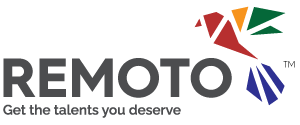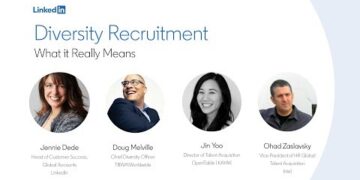One crucial factor remains consistent in business: the significance of attracting and retaining top talent. Talent acquisition serves as a cornerstone for organizational success, driving growth, innovation, and competitiveness.
But now, traditional hiring methods that heavily rely on intuition and subjective judgment are being replaced by more advanced, precise, and efficient strategies. Introducing data-driven recruitment, leading the way in this transformative revolution.
Data-driven recruitment represents a transformative shift in the hiring process. By leveraging technology, data, and analytics, companies can make strategic decisions and ensure a well-informed approach.
This method brings objectivity and precision to screening, assessing, and selecting candidates, using a wealth of data from diverse sources. Ultimately, it helps organizations find the perfect fit for their needs.
As we delve into the transformative world of data-driven recruitment, we’ll explore its profound impact on the future of talent acquisition. Redefining traditional approaches, this method empowers businesses to thrive in today’s fiercely competitive environment.
The Mechanics of Data-Driven Recruitment
In the heart of data-driven recruitment lies a complex yet elegant mechanism that leverages technology and sophisticated algorithms to transform raw data into insightful hiring decisions. Here’s a closer look at how it works.
How Data-Driven Recruitment Works
At its core, data-driven recruitment is about using data to guide hiring decisions. But how does this process work? It begins with data collection. Recruiters gather data from various sources such as:
- Resumes
- Job applications
- Social media profiles
- Online assessments.
This data forms the foundation for the subsequent stages of the recruitment process.
Once the data is collected, it’s processed and analyzed using cutting-edge algorithms. These algorithms sift through the vast amount of data, identifying patterns, trends, and correlations that might otherwise go unnoticed.
The result is a rich set of insights that recruiters can use to make informed decisions about which candidates are likely to succeed in a particular role.
To illustrate how data-driven recruitment works, let’s consider a eCommerce company looking to hire a new digital marketing manager. The process begins with data collection. The company receives numerous applications for the role, each containing a wealth of information – details about candidates’ education, work experience, skills, and more.
Simultaneously, the recruiting team also collects data from other sources like LinkedIn profiles, Twitter feeds, or even industry blogs where candidates have shared their thoughts or expertise. For instance, a candidate’s LinkedIn profile might reveal their network within the industry, while their Twitter feed could give insights into their knowledge of current digital marketing trends.
Next, this collected data is processed and analyzed using advanced algorithms. These algorithms can identify patterns and correlations in the data that are not immediately apparent.
For example, they might find that candidates who have a certain combination of skills – say, SEO expertise, proficiency in Google Analytics, and a background in content strategy – have performed exceptionally well in similar roles in the past. Or, they might discover that candidates who actively engage with industry trends on social media tend to bring innovative ideas to their roles.
Based on these insights, the recruiting team can then make informed decisions about which candidates to shortlist for the role. They can identify candidates who not only meet the basic requirements for the job but also exhibit characteristics that suggest they would excel in the role and bring value to the company.
This is a simplified example, but it illustrates the fundamental workings of data-driven recruitment. By leveraging data and technology, recruiters can uncover deeper insights about candidates and make more informed, strategic hiring decisions.
Sources of Data for Recruitment Analytics
Recruitment analytics relies on a diverse range of data sources to make informed decisions. While traditional sources like resumes and job applications offer valuable insights into a candidate’s education, work experience, and skills, recruiters now have access to an array of digital data in today’s technologically advanced era.
There are several sources of data that can be used for recruitment analytics. These include:
- Job boards and resume databases: These platforms contain a wealth of information about potential candidates, including their skills, experience, and career aspirations. They can be a valuable source of data for understanding the talent market and identifying suitable candidates.
- Social media: Platforms like LinkedIn, Facebook, and Twitter can provide insights into a candidate’s professional network, interests, and online presence. This data can be useful for assessing cultural fit and identifying passive candidates.
- Applicant Tracking Systems (ATS) & Customer Relationship Management (CRM): These systems store data on past and current applicants, including their application history, interview performance, and interactions with your company.
- Interviews and performance assessments: Data gathered during the interview process and through performance assessments can offer insights into a candidate’s skills, abilities, and potential fit within the organization.
- Organizations and associations: Professional organizations and associations can provide data on industry trends, salary benchmarks, and other relevant information that can inform recruitment strategies.
- Human Resource Information System (HRIS): An organization’s HRIS contains data on the most common HR functions including recruitment, performance management, and talent management.
- Internal data: Data from within the company, such as employee performance data, retention rates, and internal survey results, can also be used to inform recruitment strategies.
Role of Algorithms in Analyzing Recruitment Data
Algorithms play a crucial and indispensable role in the realm of data-driven recruitment. Acting as the powerful engines behind the analysis of vast recruitment data, they possess the remarkable ability to transform a seemingly overwhelming sea of information into actionable insights.
By carefully analyzing the data, these algorithms effortlessly detect complex patterns and recognize emerging trends, empowering recruiters to make well-informed projections regarding a candidate’s job performance or compatibility within a company.
In essence, these algorithms empower recruiters to peer beyond the surface-level details of a candidate’s application, unveiling profound insights that can ultimately pave the way for more discerning and effective hiring decisions.
Benefits of Data-Driven Recruitment
Data-driven recruitment has several benefits that enhance the efficiency and effectiveness of hiring processes. Let’s take a look at them:
- Improved Decision Making: Data provides objective insights that can help recruiters make informed decisions, reducing bias and improving the quality of hires.
- Efficiency: By automating parts of the recruitment process such as screening resumes and scheduling interviews, recruiters can save time and focus on more strategic tasks.
- Better Candidate Experience: Data can be used to personalize the recruitment process and improve communication with candidates, leading to a better candidate experience.
- Reduced Hiring Costs: By using data to identify the most effective recruitment channels and strategies, companies can optimize their recruitment budget and reduce hiring costs.
- Predictive Analytics: Data can be used to predict future hiring needs and identify potential talent gaps before they become a problem.
- Benchmarking: Data allows companies to benchmark their performance against industry standards and competitors, helping them identify areas for improvement.
- Increased Retention: By using data to make better hiring decisions, companies can improve employee retention and reduce turnover costs.
- Diversity and Inclusion: Data can help companies track their progress toward diversity and inclusion goals and identify any biases in their recruitment process.
Are you interested in expanding your knowledge about data-driven recruitment? Check out this informative video about data literacy!
Conclusion: Embracing the Power of Data in Recruitment
Data-driven recruitment has emerged as a transformative force in the hiring process, bringing a newfound level of rigor, objectivity, and efficiency to talent acquisition. It harnesses the power of data and technology to inform decisions, eliminate bias, and optimize resources – key benefits that make it a game-changer for businesses in all industries.
As we look towards the future, it’s clear that recruitment in the digital age will be increasingly defined by data and analytics. The ability to leverage these tools to attract and retain the right talent will be a crucial determinant of business success. Traditional methods based on intuition and subjective judgment will give way to more sophisticated, data-driven strategies.
To thrive in this new landscape, companies must embrace the power of data in their recruitment processes. This necessitates not just the adoption of new technologies, but a shift in mindset – a recognition that data and analytics are no longer optional extras, but essential components of effective recruitment.
By leveraging the power of data, companies can ensure they are well-equipped to find, attract, and retain the talent they need to succeed in the competitive business environment of the digital age.














